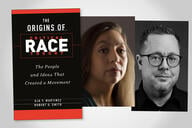You have /5 articles left.
Sign up for a free account or log in.
Just over 75 percent of Indian-born Americans have a college degree, and 42 percent have a graduate or professional degree. These percentages tower over those of other foreign-born populations (overall average of 27 percent and 11 percent for undergraduate and graduate degrees). These numbers also far exceed those for people born in the United States.
A new book explains why. The Other One Percent: Indians in America (Oxford University Press) notes of course the hard work and intelligence of Indian immigrants. But a major focus of the book is the way India's distance from the United States, democratic traditions and U.S. immigration law resulted in some of the most educated Indians migrating to the United States. And hardly anyone else.
These factors played out for those from India in a way that wasn't seen in the rest of the world, the book argues. The book explores how Indians who came to the United States were "selected for success" and how so many embraced entrepreneurial careers.
The authors of the book are Sanjoy Chakravorty, professor of geography and urban studies at Temple University; Devesh Kapur, professor of political science and director of the Center for the Advanced Study of India at the University of Pennsylvania; and Nirvikar Singh, professor of economics at the University of California, Santa Cruz. They responded via email to questions about The Other One Percent.
Q: Please explain how the 1965 immigration act had such a profound impact on the makeup of Indians who came to the United States.
A: The most important effect of the 1965 act was that it opened the door for Indians. Before that, a mix of openly racist laws and national-origin quotas had severely limited the entry of Indians and other nonwhite racial groups. The 1965 act encouraged both family reunification and the entry of skilled workers. The latter was important to Indians (as there were few Indian families then in the U.S. that could take advantage of unification). As a result, the first group that came in, between 1965 and the late-1970s, whom we call the Early Movers, were highly educated. Close to half of them arrived with (or later obtained) graduate or professional degrees. Many were doctors.
In the next phase, until the mid-1990s, family reunification did become a big driver for Indians, but after that and till today immigration from India has again heavily focused on skills, especially in engineering and IT. There is little doubt that Indian immigrants have been, over a long period, the most intense users of the skilled-worker pathway to the U.S., and this is reflected not only in the educational levels of those who are here, but in the visa and permanent resident (green card) categories under which they were admitted.
Q: For many other immigrant groups, those who came to the United States included a mix of educational attainment levels. Why was the Indian group so homogeneous (educationally)?
A: There are several reasons for this. First, India being a stable democracy meant that there were few refugees or asylum seekers from there (unlike, say, China, which sends many, and is distinct from Taiwan, which sends a population that, like India’s, is highly educated). Second, because of the distance, it is difficult for low-skilled workers to find illegal ways into the U.S. Once you eliminate these two paths (refugee/asylee and illegal) and then incorporate the random shock of the information revolution that has attracted a large fraction of the Indian immigrant stream for the last two decades, the current outcome is not that surprising.
Had the information revolution not happened, had the Y2K problem not existed, had the Indian system of higher education not geared up to meet the demand for workers in these new fields, had the American immigration system not been tweaked to admit this new type of worker, then the story could have been very different. The Indian population here could have been like the Filipino population -- educated and well-to-do but not as many with professional STEM degrees and neither very well-to-do. It would not have been the population of outliers it is today.
Q: You note that the law's requirements favored those studying science and business fields. Has the United States gotten a skewed picture of Indian talent, ignoring the humanities and other fields?
A: This is a difficult question. On the one hand, we could argue that humanities are not the domain of English speakers alone. So you could have talented people working in Hindi, Gujarati, Punjabi, Telugu, Tamil, Bangla and so on. Writers, playwrights, actors, musicians, scholars. But neither does the U.S. market for cultural labor have much need for them, nor do these creative people have much hankering to be displaced from their raw material -- their culture.
There’s a mismatch. For Indian culture producers in English, where there is less of a mismatch, the U.S. (especially New York City) is a rather important destination. And there are a fair number of India-born faculty in U.S. universities. On the other hand, the Indian system of higher education itself is strongly biased toward the STEM fields. Engineering is the default degree, failing that, science. So there’s a supply issue, too. Given the supply shortage in the humanities and the demand mismatch, we are hard-pressed to take a strong stand that the U.S. has gotten a skewed version of Indian talent.
Q: Much of your analysis focuses on the educational attainment and subsequent success of Indian-born immigrants to the United States. What patterns are we seeing among their children?
A: The children are doing very well. We don’t have a lot of robust data because the second generation is so young; over 80 percent are less than 25 years old and largely have yet to complete their education. But in those who have come of age and have finished studying and are working, we find similar levels of educational attainment and similar levels of income (if not slightly higher) as in the first generation, the direct immigrants. They are branching out into new fields -- much less engineering and a lot more bio and life sciences, more social sciences and law, and different avenues of entrepreneurship.
Q: Do your personal histories relate to the themes of this book?
A: At one level, without doubt. We are stereotypical followers of the classic graduate school path. It’s not limited to Indians, of course, because there are people of all nationalities that follow this path. Two of us got our undergraduate degrees in Indian universities and all three of us our doctorates in U.S. universities. Would we all have studied up to this level in India? Doubtful. Maybe one or two of us, but probably not all three.
The Ph.D. track is far less attractive or intellectually engaging or remunerative in India. Two of us had undergraduate degrees in engineering, so we did the classic American thing -- we reinvented ourselves. We got out of a rut and found our groove; at least, something better suited to our talents, such as they are. But at other levels, we don’t represent the typical story. At a recent event related to launching this book held in a tony setting in midtown Manhattan, the moderator asked the attendees (about 100 people) how many had come with H-1 visas (the tech worker visa). Not one hand went up. Asked about entering with student visas, half the people in the room had their hands up.
Q: President-elect Trump has said favorable things about immigrants with high-tech skills and periodically in the campaign seemed enamored with Hindu nationalists. But many American educators fear that the anti-immigrant tenor of his campaign may scare off some international talent. Do you think American universities will become less attractive to top talent from India? Why or why not?
A: This is also a difficult question, because there are two different issues here: the tech worker and the student. It is quite possible that the tech worker path may become constricted under the new administration. And that would indeed send a negative signal to Indian talent. It would very likely affect the student pathway as well. The U.K. example is instructive. The number of Indian students there has declined by half over the past four years as the government tightened poststudy work visas. But, despite the massive growth in higher education in India, the number of “quality” seats are still very small. The expansion has been more in quantity than quality. So the U.S. university system could well remain the pre-eminent overseas destination for Indian students.
Moreover, the potential students may feel somewhat reassured that many of the good American universities are in California and the Northeast, and generally in larger urban and more cosmopolitan areas. We are reminded that when the Early Movers from India came to the U.S. in the late-1960s and 1970s, the country was strongly racialized and the South still had de facto segregation. But it is entirely possible that some of the sheen will be lost, and countries like Australia and Canada, which have been trying to attract international students in a systematic way, may begin to look more attractive.




